 W
WBlaniulus guttulatus, commonly known as the spotted snake millipede is a species of millipede in the family Blaniulidae that can be found in Central and Western Europe. It has been introduced in North American countries such as the United States, Canada, Saint Helena, and Tristan da Cunha, as well as Tasmania and Norfolk Island, Australia.
 W
WBrachyiulus is a genus of millipedes, containing around eight species, most of which live in the Mediterranean Basin of Europe and Asia. The species B. pusillus has been introduced widely around the world
 W
WBrachyiulus pusillus is a species of millipede in the family Julidae. It is widespread in Europe and has also been introduced to islands around the world, continental South America, South Africa, and Oceania, and is potentially widespread in North America, although previous records may have confused B. pusilus with the related B. lusitanus. The species is brownish-black coloured and has 30–34 segments. They also have either light yellowish or reddish lines that are located closer to the centre of the back. It can be found on bushes and trees. The species are commonly found in walls or fences.
 W
WGlomeris is largely European genus of pill millipedes. It contains over 100 species, distributed across Europe, but also extending into the Canary Islands, Turkey, and eleven species from North Africa.
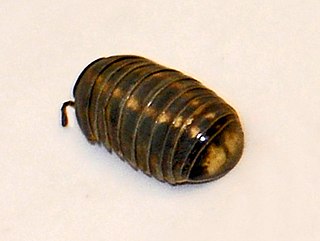 W
WGlomeris connexa is a species of pill millipedes.
 W
WGlomeris klugii is a species of pill millipedes.
 W
WGlomeris marginata is a common European species of pill millipede. It is a short millipede, rounded in cross-section, which is capable of rolling itself up into a ball ("volvation") when disturbed. This behaviour is also found in the pill woodlouse Armadillidium, with which G. marginata is often confused.
 W
WJulus scandinavius is a species of millipede from Julidae family. It was described by Latzel in 1884 and is found in Austria, Benelux, Czech Republic, France, Germany, Hungary, Ireland, Poland, Slovakia, Switzerland, Britain I. and Scandinavia.
 W
WMammamia profuga is a species of cave-dwelling millipede in the family Julidae. The only known species of the genus Mammamia, it was described in 2011 from a specimen discovered in a cave in Italy.
 W
WMegaphyllum unilineatum is a species of millipede in the family Julidae, first described by Carl Ludwig Koch in 1838. No subspecies are listed in the Catalogue of Life.
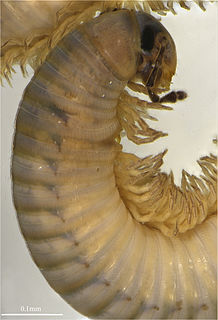 W
WOmmatoiulus avatar is a species of European millipede in the family Julidae. Individuals are known from Andalusia, southern Spain. Individuals are 25 to 38 mm long. Color in alcohol preserved specimens is brownish with yellowish and black marbling on the dorsal surface. O. avatar was described in 2015, with the aid of X-ray microtomography that produced a three-dimensional digital model, becoming the first millipede described from reference to physical type specimens as well as virtual models, known as "cybertypes".
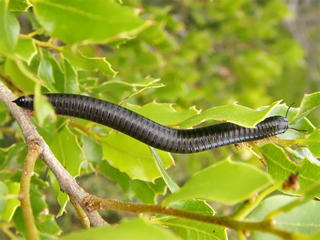 W
WOmmatoiulus moreleti, commonly known as the Portuguese millipede, is a herbivorous millipede native to the southern Iberian Peninsula where it shares its range with other Ommatoiulus species. From here, it has spread by international commerce to a number of new localities. This species was accidentally introduced into Australia without its natural enemies and has since become an invasive pest. A number of methods have been developed to manage this millipede.
 W
WOmmatoiulus sabulosus, also known as the striped millipede, is a European millipede of the family Julidae. Its common name comes from its two striking bright longitudinal bands on the dorsal surface.
 W
WOmmatoiulus sabulosus aimatopodus is a millipede occurring in the South of France; belonging to the same species than Ommatoiulus sabulosus, it differs from the type by the lack of lighter transversal lines on the back when adult. It is believed to be a Mediterranean-climate adapted variant, but whether it is a true subspecies or rather an ecomorph is unclear; first described by Antoine Risso as a distinct species, it is for now considered as a form of Ommatoiulus sabulosus, under the name Ommatoiulus sabulosus f. aimatopodus.
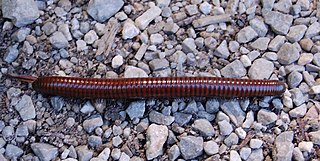 W
WPachyiulus hungaricus is a species of millipede from Julidae family that can be found in Albania, Bulgaria, Greece, Romania, and all states of former Yugoslavia.
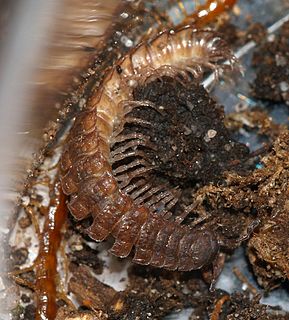 W
WPolydesmus angustus, also known as the flat-backed millipede, is a millipede in the genus Polydesmus.
 W
WPolyxenus lagurus, known as the bristly millipede is a species of millipede found in many areas of Europe and North America. It is covered with detachable bristles that have the ability to entangle ants and spiders that attack the animal.
 W
WProteroiulus fuscus is a species of millipede in the family Blaniulidae which can be found everywhere in Europe except for Albania, Andorra, Liechtenstein, Moldova, Monaco, Romania, San Marino, Vatican City, all states of former Yugoslavia and some European islands.
 W
WTachypodoiulus niger, known variously as the white-legged snake millipede or the black millipede, is a European species of millipede. It is very similar to other species such as Cylindroiulus londinensis, from which it can be reliably distinguished only by studying the shape of the telson. It occurs in Ireland, Britain, Spain, France, Benelux, Germany, Switzerland, Austria and the Czech Republic, and is especially common on chalky and limestone soils.
 W
WTitanophyllum spiliarum is a species of cave-dwelling millipede in the family Julidae. The only known species of the genus Titanophyllum, it was described in 2011 from specimens discovered in a cave in Greece. It has several unusual characteristics including eyelessness and a small hook on its hind-most body section that may be involved in keeping the animal ‘locked’ when it coils-up defensively.
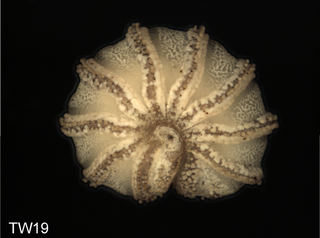 W
WTrachysphaera is a genus of pill millipedes in the order Glomerida. Around 30 species are known, making it the third most species-rich genus of Glomerida. Trachysphaera species are patchily distributed throughout Europe and western Asia, extending from Spain to Caucasia.